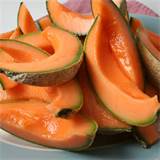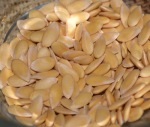 Cantaloupe and Muskmelon are can be grown in USDA Hardiness Zones: 4 to 11. They prefer Full Sun exposure, a somewhat Sandy soil that is slightly Acidic to Neutral.
Cantaloupe and Muskmelon are can be grown in USDA Hardiness Zones: 4 to 11. They prefer Full Sun exposure, a somewhat Sandy soil that is slightly Acidic to Neutral.
What we gardeners commonly refer to as ‘cantaloupe’ is actually (most likely) not a true cantaloupe, rather, it’s a type of muskmelon. (True cantaloupe has a rough, warty rind and is not widely grown or commercially available in the US.) Also known as Rockmelon in some parts of Australia and I don’t know why. Muskmelons are a heat loving fruit with a long growing season. Their cultural and growing requirements are very similar to other melons like watermelons. They have a net like, tan rind, and sweet orange flesh. The names muskmelon and cantaloupe are often used interchangeably by home gardeners. I will use the name cantaloupe when writing about Muskmelons and Cantaloupe.
Cantaloupe likes loamy, well-drained soil. Handle them gently when you transplant. Add lots of compost to the area before planting and after planting. Mulching with black plastic will serve multiple purposes. It will warm the soil, hinder weed growth and keep developing fruits clean.
Fertilize when vines start growing. While cantaloupe vines are growing, blooming, and setting fruit, they need 1 to 2 inches of water per week. Water in the morning, and try to avoid wetting the leaves. Reduce watering once fruit are growing. Dry weather produces the sweetest melon.
Once fruit begins to grow, prune end buds off vines. Your plants may produce fewer melons, but they will be larger and of better quality. Vines produce male and female flowers separately on the same plant. They often begin producing male flowers several weeks before the females appear. Don’t give up or become discouraged when the first blooms do not produce fruit. Blossoms require pollination to set fruit, so be Bee friendly. Use no insecticides that will harm bees!
When cantaloupe rinds begin to change from green to tan or yellow, the melon is probably ripe, but be careful not to pick too early. Look for a crack in the stem where it attaches to the fruit. This is a sign of ripeness. The fruit should be easy to separate from the vine, but if they fall off by themselves they are usually overripe. Harvest melons when vines are dry, and be careful not to damage them. They will soften after harvesting, but will not continue to sweeten off the vine.
Cantaloupe can be stored uncut for 5 or 6 days. If cut, they can last in the refrigerator for about 3 days, wrapped tightly in plastic.
Some of the varieties recommended by home gardeners are.
* Hale’s Best Jumbo – 80-90 days to maturity. Produces 3-pound, aromatic melons.
* Minnesota Midget – 70-80 days. Early variety suited for Northern gardens. Produces smallish 1-pound, sweet flavored melons.
* Bush Star – 90 days to maturity. Bush variety suits gardeners with limited space.
* Ambrosia – 85 days to maturity. One of the sweetest varieties.
* Source Heirloom Organics – How to Grow Cantaloupe A Guide to Growing Cantaloupe
* Source Backyard vegetable gardening – Growing Cantaloupe
 Saving Seed from the Garden Not every plant’s seeds are worth keeping. Hybrid plants are developed by crossing specific parent plants. Hybrids are wonderful plants but the seed is often sterile or does not reproduce true to the parent plant.
Saving Seed from the Garden Not every plant’s seeds are worth keeping. Hybrid plants are developed by crossing specific parent plants. Hybrids are wonderful plants but the seed is often sterile or does not reproduce true to the parent plant.
Choose disease free plants with qualities you desire. Look for the most flavorful vegetables or beautiful flowers. Consider size, harvest time and other characteristics.
Always harvest only mature seed. For example, cucumber seeds at the eating stage are not ripe and will not germinate if saved. You must allow the fruit and seed to fully mature. Because seed set reduces the vigor of the plant and discourages further fruit production, wait until near the end of the season to save fruit for seed.
Seed contained in fleshy fruits like cantaloupe should be cleaned using the wet method. Tomatoes, melons, squash, cucumber and roses are prepared this way. Scoop the seed masses out of the fruit or lightly crush fruits. Put the seed mass and a small amount of warm water in a bucket or jar. Let the mix ferment for two to four days. Stir daily. The fermentation process kills viruses and separates the good seed from the bad seed and fruit pulp. After two to four days, the good viable seeds will sink to the bottom of the container while the pulp and bad seed float. Pour off the pulp, water, bad seed and mold. Spread the good seed on a screen or paper towel to dry.
If you see or read something you like Please Share By Re-blogging or Emailing It To A Friend
Why is common sense so uncommon?
Don’t be shy. Leave me your comment(s)

I southern Australia these fruit are known as cantaloupes, however, in Queensland they are called rockmelon. I am not sure why.
Although we live in a high rainfall area (72 inches average and some years a lot more), we had a particularly dry beginning to our summer and were able to grow a crop of about 12 melons from 2 plants.
LikeLike
Re fairy – Thanks for taking time to visit my tiny blog. I sometimes fail to remember that I have visitors from other countries and fail to properly include them and address growing conditions they must deal with in their backyard gardens.
Thanks for the Rockmelon report, I can find a lot of references to rockmelons but so far no one has explained when, where or why some people/places call Cantaloupes ‘Rockmelons’
Happy fall gardening
LikeLike
Thanks for the seed collecting hints. We find locally grown melons (of various types) at the farmer’s market in the Shenandoah Valley, but here in the mountains, growing is iffy. Some years with get nothing but rind if the days get cold early. Other years, we get small, but delicious melons.
Oscar
LikeLike
There are a few smaller fruited short season varieties that may work for you
http://www.seedman.com/melons.htm
I hope you can find one that will produce reliably for you.
Don’t forget to save seed when you find the one that works well in your area.
Sweet melon eating this season.
LikeLike
This is really great information; thanks for sharing (along with the original source)! Now if I could successfully combat all the insects that like to attack cucurbits!!!
LikeLike